The cryogenic helium cycling system market is projected to grow from USD 113.4 million in 2025 to USD 177.8 million by 2035, creating a clear landscape of emerging opportunity across research, medical, and industrial environments. A major opportunity exists in the adoption of closed cycle helium recovery systems, which allow facilities to capture, purify, and reuse helium rather than depend on repeated procurement of new supply. Users are prioritizing solutions that support long-term resource security and stable operational planning, as global helium availability tightens and procurement costs rise.
Biomedical imaging centers and research institutions are also driving growth, especially in MRI and NMR magnet cooling applications, where continuous and reliable cryogenic performance is required. Hospitals and academic laboratories are shifting from manual refill systems to automated cycling platforms to minimize downtime and enhance operational efficiency. In industrial applications, demand is increasing in semiconductor fabrication, superconducting materials processing, and quantum computing component development, where precise ultra-low temperature stability enables high-performance outcomes. An additional opportunity is emerging for compact, modular, and energy-efficient cryogenic units designed for smaller laboratory environments and mobile research setups.

The latter half (2030-2035) will witness steady growth from USD 148.5 million to USD 177.8 million, representing an addition of USD 29.3 million or 45.5% of the decade's expansion. This period will be defined by mass market penetration of specialized cycling system designs, integration with comprehensive cryogenic management platforms, and seamless compatibility with existing ultra-low temperature infrastructure. The market trajectory signals fundamental shifts in how research facilities approach helium management optimization and cryogenic efficiency quality management, with participants positioned to benefit from steady demand across multiple cycle types and application segments.
The market demonstrates distinct growth phases with varying market characteristics and competitive dynamics. Between 2025 and 2030, the market progresses through its technology adoption phase, expanding from USD 113.4 million to USD 148.5 million with steady annual increments averaging 4.6% growth. This period showcases the transition from basic helium cycling formulations to advanced closed cycle systems with enhanced recovery capabilities and integrated cryogenic control systems becoming mainstream features.
The 2025-2030 phase adds USD 35.1 million to market value, representing 54.5% of total decade expansion. Market maturation factors include standardization of cryogenic research and ultra-low temperature protocols, declining component costs for specialized cycling formulations, and increasing scientific awareness of helium conservation benefits reaching optimal recovery effectiveness in industrial and biomedical applications. Competitive landscape evolution during this period features established manufacturers like Bluefors and Cryomech expanding their helium cycling portfolios while specialty manufacturers focus on advanced technology development and enhanced cooling capabilities.
From 2030 to 2035, market dynamics shift toward advanced cryogenic integration and global research expansion, with growth continuing from USD 148.5 million to USD 177.8 million, adding USD 29.3 million or 45.5% of total expansion. This phase transition centers on specialized cycle type systems, integration with automated cryogenic networks, and deployment across diverse industrial and laboratory scenarios, becoming standard rather than specialized applications. The competitive environment matures with focus shifting from basic cooling capability to comprehensive helium management optimization systems and integration with research monitoring platforms.
At-a-Glance Metrics
| Metric | Value |
|---|---|
| Market Value (2025) | USD 113.4 million |
| Market Forecast (2035) | USD 177.8 million |
| Growth Rate | 4.6% CAGR |
| Leading Technology | Closed Cycle Type |
| Primary Application | Industrial Manufacturing Application Segment |
The market demonstrates strong fundamentals with closed cycle systems capturing a dominant share through advanced helium recovery and cryogenic optimization capabilities. Industrial manufacturing applications drive primary demand, supported by increasing ultra-low temperature research and specialized cooling technology requirements. Geographic expansion remains concentrated in developed markets with established scientific research infrastructure, while emerging economies show accelerating adoption rates driven by research facility expansion and rising helium conservation standards.
Market expansion rests on three fundamental shifts driving adoption across the industrial manufacturing, biomedical, and laboratory sectors. First, helium conservation demand creates compelling operational advantages through cryogenic helium cycling systems that provide immediate temperature control and gas recovery without compromising research productivity, enabling facilities to meet stringent cost efficiency standards while maintaining operational effectiveness and reducing helium consumption. Second, cryogenic technology modernization accelerates as research institutions worldwide seek advanced cycling systems that complement traditional cooling processes, enabling precise temperature management and helium recovery that align with scientific standards and sustainability regulations.
Third, ultra-low temperature capability enhancement drives adoption from industrial manufacturers and biomedical research facilities requiring effective cooling solutions that maximize helium efficiency while maintaining operational reliability during cryogenic experiments and material processing operations. Growth faces headwinds from system cost challenges that vary across cycling suppliers regarding the pricing of advanced cryogenic systems and specialty components, which may limit adoption in cost-sensitive environments. Technical limitations also persist regarding maintenance complexity and temperature stability concerns that may reduce effectiveness in continuous operation scenarios and extreme cooling conditions, which affect system performance and operational requirements.
The cryogenic helium cycling system market represents a specialized yet critical cooling opportunity driven by expanding global research capacity, helium conservation modernization, and the need for superior ultra-low temperature control in diverse scientific applications. As research facilities worldwide seek to achieve optimal helium recovery, reduce operational costs, and integrate advanced cycling systems with automated platforms, cryogenic helium cycling systems are evolving from basic cooling equipment to sophisticated cryogenic solutions ensuring operational efficiency and resource conservation leadership.
The market's growth trajectory from USD 113.4 million in 2025 to USD 177.8 million by 2035 at a 4.6% CAGR reflects fundamental shifts in scientific research requirements and helium management optimization. Geographic expansion opportunities are particularly pronounced in Asia Pacific markets, while the dominance of closed cycle systems and industrial manufacturing applications provides clear strategic focus areas.
Strengthening the dominant closed cycle segment through enhanced helium recovery, superior cooling efficiency, and automated cryogenic control systems. This pathway focuses on optimizing helium conservation, improving temperature stability, extending operational effectiveness to optimal recovery rates, and developing specialized formulations for diverse applications. Market leadership consolidation through advanced cryogenic engineering and automated system integration enables premium positioning while defending competitive advantages against alternative cooling methods. Expected revenue pool: USD 20-27 million
Rapid industrial manufacturing and scientific research growth across Asia Pacific creates substantial expansion opportunities through local production capabilities and technology transfer partnerships. Growing research investment and government scientific initiatives drive steady demand for advanced helium cycling systems. Localization strategies reduce import costs, enable faster technical support, and position companies advantageously for procurement programs while accessing growing domestic markets. Expected revenue pool: USD 17-23 million
Expansion within the dominant industrial manufacturing segment (estimated 40.0% market share) through specialized cycling designs addressing cryogenic processing standards and high-reliability requirements. This pathway encompasses material testing systems, superconducting magnet cooling, and compatibility with diverse manufacturing processes. Premium positioning reflects superior helium recovery and comprehensive operational compliance supporting modern industrial operations. Expected revenue pool: USD 14-19 million
Strategic expansion into biomedical applications (estimated 30.0% market share) requires enhanced temperature stability capabilities and specialized cycling formulations addressing medical research operational requirements. This pathway addresses MRI cooling, cryopreservation systems, and medical device testing designs with advanced cryogenic engineering for demanding biomedical standards. Premium pricing reflects specialized application requirements and extended reliability standards. Expected revenue pool: USD 12-16 million
Development of specialized cycling formulations for laboratory applications (estimated 25.0% share) and other segments (5.0%), addressing specific research requirements and niche cryogenic demands. This pathway encompasses quantum computing cooling, materials science research, and cost-effective alternatives for emerging scientific segments. Technology differentiation through proprietary cycling designs enables diversified revenue streams while reducing dependency on single application platforms. Expected revenue pool: USD 10-14 million
Expansion of open cycle segment (estimated 25.0% market share) through enhanced cooling capacity, specialized high-flow applications, and demanding research requirements. This pathway encompasses large-scale cooling applications, temporary research setups, and specialty formulations requiring flexible helium supply characteristics. Market development through advanced flow engineering enables differentiated positioning while accessing specialized markets requiring highest-capacity cooling solutions. Expected revenue pool: USD 8-11 million
Development of hybrid cycling system formulations (estimated 10.0% market share) addressing flexible operational requirements and efficiency optimization across industrial and laboratory applications. This pathway encompasses adaptive cooling modes, energy optimization, and comprehensive operational flexibility. Premium positioning reflects technological innovation and versatility expertise while enabling access to multi-purpose research programs and efficiency-driven scientific partnerships. Expected revenue pool: USD 7-9 million
Primary Classification: The market segments by cycle type into Closed Cycle, Open Cycle, and Hybrid categories, representing the evolution from basic cooling systems to specialized helium cycling solutions for comprehensive cryogenic optimization.
Secondary Classification: Application segmentation divides the market into Industrial Manufacturing, Biomedical, Laboratory, and Others sectors, reflecting distinct requirements for cooling capacity, temperature ranges, and helium recovery standards.
Regional Classification: Geographic distribution covers Asia Pacific, Europe, North America, and other regions, with developed markets leading adoption while emerging economies show accelerating growth patterns driven by research facility expansion programs.
The segmentation structure reveals technology progression from standard open cycle formulations toward specialized closed and hybrid systems with enhanced recovery and efficiency capabilities, while application diversity spans from industrial manufacturing to specialized biomedical and laboratory applications requiring precise cycling solutions.
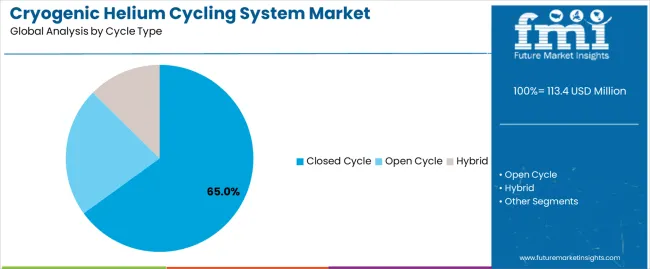
Market Position: Closed cycle systems command the leading position in the market with approximately 65.0% market share through advanced helium conservation technology, including superior recovery efficiency, minimal helium loss capability, and operational optimization that enable facilities to achieve optimal cryogenic performance across diverse industrial and research environments.
Value Drivers: The segment benefits from facility preference for ecofriendly cycling systems that provide consistent cooling capacity, reduced helium consumption, and operational efficiency without requiring continuous helium supply. Advanced cryogenic features enable automated temperature control, helium recirculation, and integration with existing research equipment, where recovery reliability and cost-effectiveness represent critical operational requirements.
Competitive Advantages: Closed cycle systems differentiate through proven helium conservation, consistent temperature performance, and integration with automated cryogenic systems that enhance operational effectiveness while maintaining optimal cooling suitable for diverse scientific applications.
Key market characteristics:
Open cycle systems maintain specialized cooling positioning in the market due to their high-capacity properties and flexible cooling advantages. These systems appeal to facilities requiring straightforward cooling capabilities with superior flow rates for short-term cryogenic applications. Market adoption is driven by temporary research expansion, focusing high-throughput cooling solutions and operational flexibility through optimized open cycle designs while maintaining comprehensive temperature control capabilities.
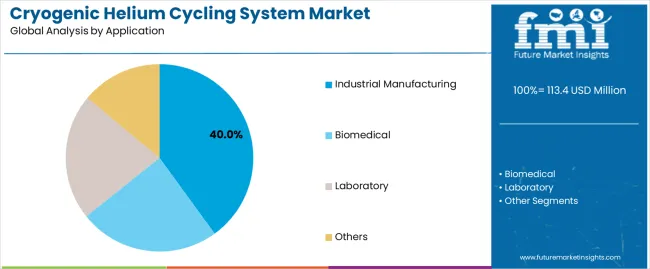
Market Context: Industrial manufacturing applications dominate the market with approximately 40.0% market share due to widespread adoption of ultra-low temperature systems and increasing focus on material processing, superconducting technology, and quality testing applications that minimize production delays while maintaining manufacturing standards.
Appeal Factors: Industrial manufacturers prioritize cooling reliability, helium efficiency, and integration with existing production infrastructure that enables coordinated cycling system deployment across multiple testing facilities. The segment benefits from substantial industrial investment and modernization programs that emphasize the acquisition of helium cycling systems for quality control and research applications.
Growth Drivers: Industrial facility expansion programs incorporate cryogenic helium cycling systems as standard cooling equipment for material testing operations, while superconducting technology growth increases demand for ultra-low temperature capabilities that comply with manufacturing standards and minimize helium costs.
Market Challenges: Varying industrial standards and material processing differences may limit cycling system standardization across different production facilities or operational scenarios.
Application dynamics include:
Biomedical applications capture approximately 30.0% market share through specialized cooling requirements in medical research facilities, MRI operations, and cryopreservation applications. These facilities demand reliable cycling systems capable of maintaining precise temperatures while providing efficient helium management and continuous operational capabilities.
Laboratory applications account for approximately 25.0% market share, while other segments capture 5.0%, including quantum computing research, particle physics experiments, and specialty scientific applications requiring helium cycling capabilities for ultra-low temperature optimization and resource conservation compliance.
Growth Accelerators: Research facility modernization drives primary adoption as cryogenic helium cycling systems provide superior helium conservation capabilities that enable scientific operations to meet stringent cost efficiency standards without excessive operational expenses, supporting research operations and facility missions that require effective ultra-low temperature cooling applications. Helium resource management infrastructure demand accelerates market expansion as research facilities seek effective recycling systems that minimize helium consumption while maintaining operational effectiveness during cryogenic experiments and material testing scenarios. Scientific research investment increases worldwide, creating steady demand for advanced cycling systems that complement traditional cooling processes and provide resource efficiency in competitive research markets.
Growth Inhibitors: System capital cost challenges vary across cycling suppliers regarding the pricing of advanced cryogenic systems and specialty refrigeration components, which may limit operational flexibility and market penetration in regions with constrained research budgets or cost-sensitive facility operations. Technical performance limitations persist regarding maintenance complexity and operational stability concerns that may reduce effectiveness in continuous operation environments, high-duty cycle applications, or facilities with limited technical expertise, affecting cooling reliability and operational requirements. Market fragmentation across multiple research standards and cooling configurations creates compatibility concerns between different cycling suppliers and existing cryogenic infrastructure.
Market Evolution Patterns: Adoption accelerates in advanced research institutions and industrial material testing sectors where helium conservation justifies cycling system investment costs, with geographic concentration in developed markets transitioning toward mainstream adoption in emerging economies driven by research facility expansion and resource awareness. Technology development focuses on enhanced recovery efficiency, improved temperature stability, and compatibility with automated cryogenic systems that optimize helium management and operational effectiveness. The market could face disruption if alternative cooling technologies or helium-free innovations significantly limit the deployment of helium cycling systems in cryogenic applications, though helium cycling systems' unique combination of ultra-low temperature capability, resource conservation, and operational reliability continues to make them preferred in advanced research applications.
The market demonstrates varied regional dynamics with Growth Leaders including China (6.2% CAGR) and India (5.7% CAGR) driving expansion through research facility capacity additions and scientific infrastructure programs. Steady Performers encompass Germany (5.2% CAGR), Brazil (4.8% CAGR), and United States (4.3% CAGR), benefiting from established research industries and advanced cryogenic technology adoption. Mature Markets feature United Kingdom (3.9% CAGR) and Japan (3.4% CAGR), where specialized scientific applications and helium conservation integration support consistent growth patterns.
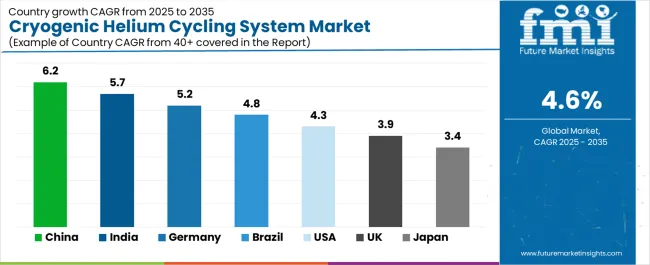
| Country | CAGR (2025-2035) |
|---|---|
| China | 6.2% |
| India | 5.7% |
| Germany | 5.2% |
| Brazil | 4.8% |
| United States | 4.3% |
| United Kingdom | 3.9% |
| Japan | 3.4% |
Regional synthesis reveals Asia Pacific markets leading adoption through research facility expansion and cryogenic technology infrastructure development, while European countries maintain steady expansion supported by scientific technology advancement and helium conservation standardization requirements. North American markets show moderate growth driven by industrial manufacturing applications and research integration trends.
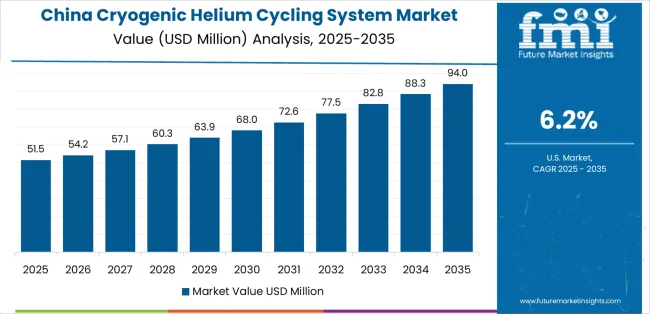
The Chinese market emphasizes advanced cryogenic features, including precision temperature control and integration with comprehensive research management platforms that manage cooling quality, helium recovery optimization, and cycling applications through unified monitoring systems. The country demonstrates strong growth at 6.2% CAGR, driven by research facility modernization, scientific infrastructure initiatives, and emerging quantum technology development that support helium cycling integration. Chinese research operations prioritize operational effectiveness with cryogenic helium cycling systems delivering consistent cooling performance through advanced recovery capabilities and system adaptation features.
Technology deployment channels include major research institutions, specialized cryogenic equipment distributors, and scientific procurement programs that support professional applications for complex ultra-low temperature cooling and helium management applications. Research platform integration capabilities with established scientific systems expand market appeal across diverse operational requirements seeking temperature stability and conservation benefits. The expanding research base and accelerating quantum computing market create steady demand, while innovative applications in superconducting technology and materials science open new growth avenues.
Performance Metrics:
Germany's advanced research market demonstrates sophisticated helium cycling system deployment with documented operational effectiveness in industrial manufacturing applications and scientific facilities through integration with existing cryogenic systems and research infrastructure. The country leverages engineering expertise in ultra-low temperature technology and scientific systems integration to maintain strong growth at 5.2% CAGR. Research centers, including Munich, Dresden, and Heidelberg, showcase premium installations where helium cycling systems integrate with comprehensive cryogenic platforms and quality management systems to optimize scientific operations and cooling effectiveness.
German research operations prioritize system reliability and helium efficiency in cycling development, creating demand for certified cryogenic systems with advanced features, including automated recovery monitoring and temperature stability optimization. The market benefits from established scientific research infrastructure and commitment to invest in advanced cryogenic technologies that provide long-term operational benefits and compliance with EU research and environmental standards.
Market Intelligence Brief:
The USA market demonstrates sophisticated deployment across industrial manufacturing applications with documented effectiveness in research laboratories and quantum computing facilities through integration with comprehensive cryogenic management systems and scientific infrastructure. The country leverages advanced research capabilities in cooling innovation and helium conservation technologies to maintain moderate growth at 4.3% CAGR. Research centers, including Massachusetts, California, and Illinois, showcase premium installations where helium cycling systems integrate with comprehensive scientific platforms and automated cryogenic networks to optimize temperature control and operational effectiveness.
American research operations prioritize cooling reliability and helium efficiency in cycling development, creating demand for certified systems with advanced features, including smart monitoring integration and predictive maintenance capabilities. The market benefits from established scientific research infrastructure and willingness to invest in advanced cryogenic technologies that provide long-term operational benefits and compliance with research funding and efficiency standards.
Market Intelligence Brief:
The UK market demonstrates advanced research deployment with documented operational effectiveness in laboratory applications and scientific facilities through integration with existing cryogenic systems and research infrastructure. The country leverages scientific expertise in helium management and ultra-low temperature systems integration to maintain steady growth at 3.9% CAGR. Research centers, including Cambridge, Oxford, and London, showcase quality installations where helium cycling systems integrate with comprehensive cryogenic platforms and research management systems to optimize scientific compliance and cooling effectiveness.
British research operations prioritize system efficiency and helium conservation in cycling development, creating demand for certified cryogenic systems with advanced features, including automated efficiency monitoring and recovery optimization. The market benefits from established scientific infrastructure and commitment to invest in quality cryogenic technologies that provide long-term operational benefits and compliance with UK and EU research standards. Laboratory applications, biomedical research operations, and quantum computing facilities drive diversified demand across multiple scientific segments.
Strategic Market Indicators:
India's market demonstrates rapid expansion deployment with documented operational effectiveness in research facility applications and industrial operations through integration with emerging scientific systems and technology development infrastructure. The country leverages growing research capabilities in cryogenic technology and scientific systems integration to achieve high growth at 5.7% CAGR. Research centers, including Bangalore, Mumbai, and Delhi, showcase expanding installations where helium cycling systems integrate with comprehensive scientific platforms and research networks to optimize market penetration and cooling effectiveness.
Indian research operations prioritize cost-effectiveness and operational standards in cycling development, creating demand for reliable cryogenic systems with essential features, including basic helium recovery and temperature monitoring systems. The market benefits from expanding scientific infrastructure and willingness to invest in international-standard cryogenic technologies that provide operational efficiency and compliance with Indian research standards.
Market Intelligence Brief:
Brazil's market demonstrates consistent expansion deployment with documented operational effectiveness in laboratory applications and research facilities through integration with developing scientific systems and cryogenic infrastructure. The country leverages research capabilities in materials science and biomedical operations to maintain steady growth at 4.8% CAGR. Research centers, including São Paulo, Rio de Janeiro, and Campinas, showcase growing installations where helium cycling systems integrate with scientific platforms and research networks to optimize cooling coverage and efficiency effectiveness.
Brazilian research operations prioritize system reliability and operational efficiency in cycling development, creating demand for robust cryogenic systems with practical features, including simplified maintenance and technical support. The market benefits from expanding scientific infrastructure and research investment in cryogenic technologies that provide operational benefits and compliance with Brazilian research standards.
Market Intelligence Brief:
Japan's market demonstrates precision deployment with documented operational effectiveness in industrial manufacturing applications and research facilities through integration with advanced cryogenic systems and quality control infrastructure. The country leverages engineering excellence in precision cooling and ultra-low temperature systems integration to maintain steady growth at 3.4% CAGR. Research centers, including Tokyo, Osaka, and Tsukuba, showcase premium installations where helium cycling systems integrate with comprehensive quality platforms and scientific management systems to optimize cryogenic excellence and operational effectiveness.
Japanese research operations prioritize system precision and helium conservation excellence in cycling development, creating demand for ultra-reliable cryogenic systems with advanced features, including micro-precision temperature control and comprehensive quality integration systems. The market benefits from established scientific infrastructure and commitment to invest in highest-quality cryogenic technologies that provide superior operational performance and compliance with stringent Japanese research standards.
Strategic Market Indicators:

The cryogenic helium cycling system market in Europe is projected to grow substantially over the forecast period, with Germany expected to maintain its leadership position with a significant market share supported by its advanced research infrastructure and major scientific centers in Munich and Dresden. The United Kingdom follows with strong market presence, driven by comprehensive research facility modernization programs and scientific excellence initiatives. France holds substantial market share through specialized quantum research activities, materials science operations, and industrial cryogenic applications. Italy commands notable market presence through strong research facilities and scientific technology projects. Spain accounts for growing market share aided by research expansion and cryogenic technology adoption. The Netherlands maintains steady share driven by specialty physics research and ultra-low temperature demand. The Rest of Europe region is anticipated to show steady adoption, reflecting consistent growth in Nordic countries, research expansion in Central European markets, and facility modernization upgrades across Eastern European scientific operations.

In Japan, the market prioritizes closed cycle systems, which capture the dominant share of research facility and industrial manufacturing installations due to their proven features, including reliable helium recovery optimization and seamless integration with existing cryogenic infrastructure. Japanese research operations emphasize reliability, precision, and long-term operational excellence, creating demand for closed cycle systems that provide consistent cooling capabilities and superior helium conservation performance based on facility requirements and efficiency standards. Open cycle maintains secondary positions primarily in specialized high-capacity applications and temporary research installations where high-flow functionality meets operational requirements without compromising cooling capacity.
Market Characteristics:
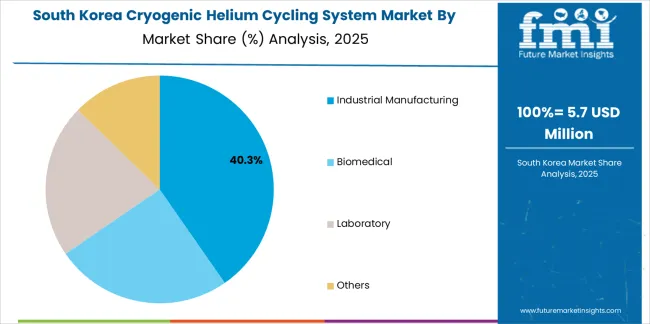
In South Korea, the market structure favors international cryogenic equipment manufacturers, including Bluefors, Cryomech, and Oxford Instruments, which maintain dominant positions through comprehensive product portfolios and established research networks supporting both industrial manufacturing cooling and laboratory research installations. These providers offer integrated solutions combining advanced helium cycling systems with professional technical services and ongoing maintenance support that appeal to Korean facilities seeking reliable cryogenic systems. Local equipment distributors and service providers capture moderate market share by providing localized support capabilities and competitive pricing for standard cooling installations, while domestic manufacturers focus on specialized applications and cost-effective solutions tailored to Korean research market characteristics.
Channel Insights:
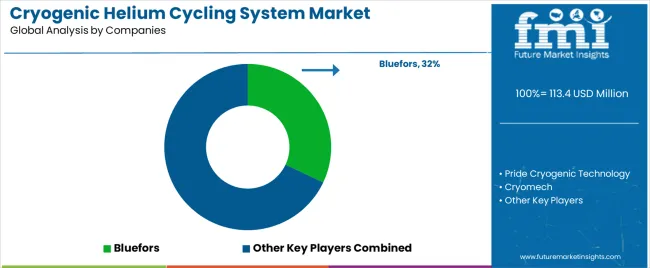
The market operates with moderate concentration, featuring approximately 8-10 meaningful participants, where leading companies control roughly 65-70% of the global market share through established research relationships and comprehensive cryogenic equipment portfolios. Competition emphasizes advanced helium recovery capabilities, cooling reliability, and scientific integration rather than price-based rivalry. The leading company, Bluefors, commands approximately 32.0% market share through its extensive helium cycling system product line and global scientific research presence.
Market Leaders encompass Bluefors, Cryomech, and Oxford Instruments, which maintain competitive advantages through extensive cryogenic technology expertise, global research networks, and comprehensive helium management capabilities that create customer loyalty and support premium pricing. These companies leverage decades of ultra-low temperature experience and ongoing innovation investments to develop advanced cycling systems with precision temperature control and recovery features. Technology Innovators include Pride Cryogenic Technology, Trillium, and regional specialists, which compete through specialized helium cycling technology focus and innovative conservation capabilities that appeal to facilities seeking advanced cryogenic solutions and operational optimization.
These companies differentiate through rapid product development cycles and specialized application focus. Regional Specialists feature cryogenic equipment manufacturers focusing on specific geographic markets and specialized applications, including quantum computing systems and integrated research solutions. Market dynamics favor participants that combine reliable cooling performance with advanced helium conservation capabilities, including precision temperature design and automatic recovery integration features. Competitive pressure intensifies as traditional laboratory equipment suppliers expand into cryogenic cycling systems, while specialized ultra-low temperature companies challenge established players through innovative helium management solutions and automated platforms targeting research facility and industrial manufacturing segments.
| Item | Value |
|---|---|
| Quantitative Units | USD 113.4 million |
| Cycle Type | Closed Cycle, Open Cycle, Hybrid |
| Application | Industrial Manufacturing, Biomedical, Laboratory, Others |
| Regions Covered | Asia Pacific, Europe, North America, Latin America, Middle East & Africa |
| Countries Covered | China, India, Germany, Brazil, United States, United Kingdom, Japan, and 20+ additional countries |
| Key Companies Profiled | Bluefors, Pride Cryogenic Technology, Cryomech, Trillium, LINKPHYSICS, Beijing Physike Technology |
| Additional Attributes | Dollar sales by cycle type and application categories, regional adoption trends across Asia Pacific, Europe, and North America, competitive landscape with cryogenic equipment manufacturers and research suppliers, facility preferences for helium conservation and cooling reliability, integration with scientific platforms and temperature monitoring systems, innovations in recovery materials and cryogenic excellence, and development of automated helium management solutions with enhanced performance and operational optimization capabilities. |
The global cryogenic helium cycling system market is estimated to be valued at USD 113.4 million in 2025.
The market size for the cryogenic helium cycling system market is projected to reach USD 177.8 million by 2035.
The cryogenic helium cycling system market is expected to grow at a 4.6% CAGR between 2025 and 2035.
The key product types in cryogenic helium cycling system market are closed cycle, open cycle and hybrid.
In terms of application, industrial manufacturing segment to command 40.0% share in the cryogenic helium cycling system market in 2025.






Full Research Suite comprises of:
Market outlook & trends analysis
Interviews & case studies
Strategic recommendations
Vendor profiles & capabilities analysis
5-year forecasts
8 regions and 60+ country-level data splits
Market segment data splits
12 months of continuous data updates
DELIVERED AS:
PDF EXCEL ONLINE
Cryogenic Vial Market Size and Share Forecast Outlook 2025 to 2035
Cryogenic Label Market Size and Share Forecast Outlook 2025 to 2035
Cryogenic Temperature Controller Market Size and Share Forecast Outlook 2025 to 2035
Cryogenic Vaporizer Market Size and Share Forecast Outlook 2025 to 2035
Cryogenic Air Separation Unit Market Size and Share Forecast Outlook 2025 to 2035
Cryogenic Freezers Market Size and Share Forecast Outlook 2025 to 2035
Cryogenic Boxes Market Size and Share Forecast Outlook 2025 to 2035
Cryogenic Tanks Market Size and Share Forecast Outlook 2025 to 2035
Cryogenic Ampoules Market Size and Share Forecast Outlook 2025 to 2035
Cryogenic Capsules Market Growth - Demand & Forecast 2025 to 2035
Cryogenic Vials and Tubes Market Size and Share Forecast Outlook 2025 to 2035
Cryogenic Pump Market Size & Trends 2025 to 2035
Cryogenic Valves Market Growth - Trends & Forecast 2025 to 2035
Competitive Overview of Cryogenic Insulation Films Companies
Market Share Distribution Among Cryogenic Label Providers
Cryogenic Insulation Films Market Report – Demand, Trends & Industry Forecast 2025-2035
Analyzing Cryogenic Ampoules Market Share & Industry Leaders
Cryogenic Technology Market
Cryogenic vial rack Market
Cryogenic Systems Market Size and Share Forecast Outlook 2025 to 2035

Thank you!
You will receive an email from our Business Development Manager. Please be sure to check your SPAM/JUNK folder too.
Chat With
MaRIA